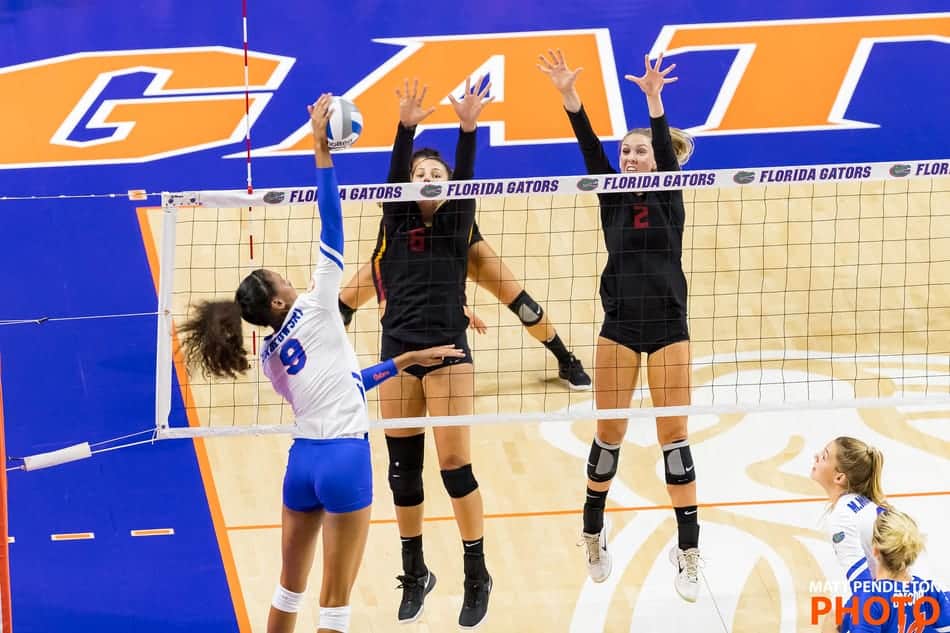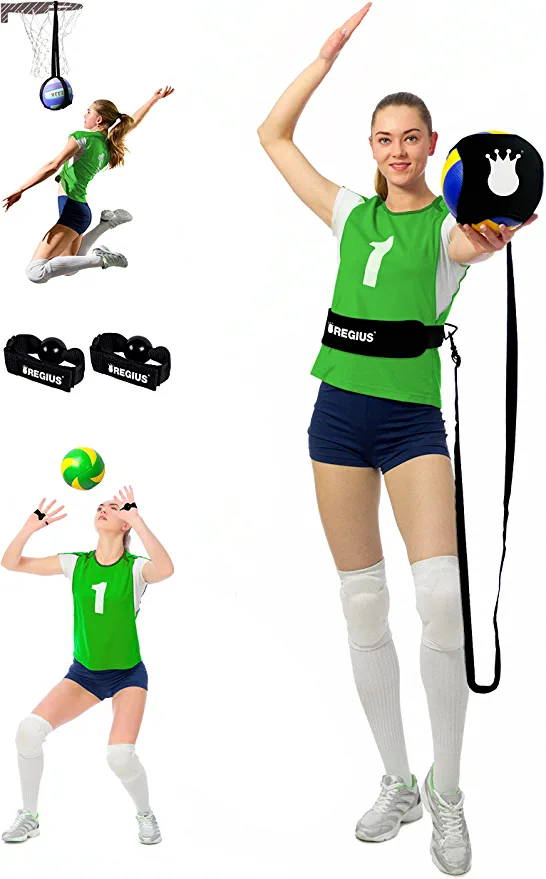Spiking in volleyball is like the ultimate power move. It’s when a player jumps up and smacks the ball with all their might, making it plummet to the ground on the other side of the net like a missile. It’s a thrilling way to score a point and show off your skills.
Plus, it’s the perfect chance to give your opponents a taste of their own medicine. But you must aim well, because if the other team manages to return your spike, it could mean game over for you!
How Do You Spike the Volleyball Step by Step?
The basics of spiking a volleyball are the same for everyone starting out, regardless of age. It can be intimidating, stressful, exhilirating, and exciting to learn to spike, all at the same time.

Here are the steps to follow when spiking in volleyball:
- Position yourself: Stand at the front of the court, about a step or two inside the 3-meter line. You want to be close enough to the net so that you can jump and reach it as you connect with the ball, but not so close that you’ll run into it.
- Take a running start: Begin your approach by taking a few quick steps to build up momentum – you want to step LEFT, RIGHT, LEFT, then bring your right foot up to jump off with both feet. Keep your feet shoulder-width apart and your eyes on the ball.
- Jump and begin to swing your arms: As you approach the net, jump off both feet and extend your non-hitting arm upward in front of you, while you coil your hitting arm back, then quickly swing to to reach the ball. Make sure to fully extend your arm and wrist so that you can hit the ball with maximum force.
- Contact the ball with an open palm: As you make contact with the ball, use your open hand and hit the ball with the meat of your hand, not your fingers. This will give you a firm, powerful hit and help you control the direction of the ball.
- Follow through and land: After you hit the ball, continue your arm motion and follow through with your hand. As you land, make sure to bend your knees to absorb the impact and maintain your balance.
With practice and repetition, spiking will become easier and more natural. Just remember to focus on technique and aim for a spot in the opponent’s court that is difficult to defend.
Some Spiking Tips for Beginners
If you’re just beginning, it can be difficult to find your groove with hitting. There are so many parts to a successful attack – the transition, the approach, the jump, the swing… it may be hard to tell what to focus on first.
Here are some tips for beginners learning how to spike in volleyball:
- Practice your approach and jump: The approach and jump are crucial to a successful spike. Practice running and jumping to get a feel for the timing and technique without the ball.
- Use an open palm to hit the ball: A closed fist may sound good, but it makes it less predictable and more difficult to control the ball and send it where you’re aiming.
- Follow through with your arm and hand: After you hit the ball, continue your arm motion and follow through with your hand. This helps to generate power and control the direction of the ball.
- Aim for a difficult spot in the opponent’s court: Try to hit the ball to a spot on the other side of the net that is difficult for the other team to defend. This might be a tight angle or a spot near the antennae.
- Work on your tranistion footwork: Good footwork before you make your approach is essential for moving quickly and positioning yourself for a successful spike. Practice shuffling, crossing, and shuffling-and-crossing to improve your footwork.
- Don’t be afraid to ask for help: If you’re having trouble with your spike, don’t be afraid to ask your coach or a more experienced player for help. They can provide valuable feedback and guidance to help you improve.
Would you like to shop for our favorite recommended player products? Choose the item below and click to shop on Amazon.
How Can I Spike the Ball Harder?
Everyone would like to make their spikes harder to get the kill, right? But what’s the secret? How do some players get so good at spiking while the rest of us struggle?
There are several factors that can affect the power of your spike in volleyball. We’re going to break these tips up into 2 categories:

Spiking Harder Through Conditioning
As obvious as it may sound, so many players want to just practice and hope that it will give them the improvement they are looking for. If you are serious about taking your game to the next level, you will need to use some resistance training or weightlifting to increase your power.
Here are some weight training tips to help you spike the ball harder:
- Build your core: One of the most underemphasized bodyparts in the hitting motion is your core. You want to do a crunch in the air as you’re swinging, so build your core with crunches, planks, twisting exercises and anything else that will tighten that abdomen.
- Build up your arm and upper body strength: Stronger arm and upper body muscles can help you generate more power in your attack. Incorporate exercises such as push-ups, bench press, and dumbbell rows into your strength training routine to build up these muscles.
- Jump higher: The higher you jump, better angle and more time you’ll have to hit the ball. Work on your vertical jump by incorporating exercises such as jump squats, tuck jumps, and box jumps into your training routine.
- Use your legs to generate power: Your legs are a powerful source of energy and can help you generate more power in your spike. When you approach the net, push off with both legs and use your quadriceps, hamstrings, and glutes to generate force.
Spiking Harder Through Proper Technique
It may shock you how much you may be able to improve your hits with focusing on proper technique. This is one of the skills where a session with a personal volleyball trainer, or hitting-specific coach may be well worth investing in. Often they can teach you what you need to raise your hitting game in a single session and you can practice proper technique on your own.
- Attack with an open palm until you’re very consistent at connecting with the ball and controling it’s direction, but then progress to using a flat hand. The flat hand will generate more pop on the ball once you master it.
- Learn the mechanics of leverage in your hitting arm. When a player is using their whole arm to whip toward the ball, there is only so fast your hand can move through the air. When you use your elbow and wrist in a proper hinging swing, you can generate so much more hand speed!
- Crunch your core as you swing. This takes a lot of practice, and can feel very awkward, but it adds so much to your power.
Mastering your spiking skill can take a long time for some players, but if you focus on it and get help from the right coaches, you may be able to make significant progress pretty quickly.
A great way to improve your attack is to learn to Nail Your Hand Position While Spiking.
How To Spike a Volleyball If You Are Short
It can be so intimidating to play against taller players, but you will likely see that there are some shorter players who can get up there and compete far better than anyone might expect. If you would like to be one of these short packages of hitting power, consider these ideas:
- You’ll need to jump higher: SO MANY of the tall players can’t jump to save their lives, but you can! Improving your vertical jump can help you reach higher and get the angle you need on your spike. Work on your jumping ability by incorporating exercises such as jump squats, tuck jumps, and box jumps into your training routine.
- Fake it ’til you make it: Until you’re able to get up there above the net and crush it, practice the very best technique you can at whatever height you can reach. As you continue to train and mature, hopefully your vertical will increase. Then, you’ll have the skills to blow them away!
- Aim for the corners: Instead of trying to hit the ball straight across the net, down the middle of the court, consider aiming for the corners. This will allow you to use the angle of the ball to your advantage and make it harder for the other team to defend.
- Become strategic when you’re hitting into the block: Many hitters simply hit as hard as they can into the block and hope for the best. When you’re able to develop the skill of watching the block and either hitting around it, or tipping over or to the side of it, you’ll differentiate yourself as an excellent attacker.
So many shorter players give up on the idea of playing the hitter and get assigned positions they would rather not play. While you may need to fill a different role, you can always look to improve your attack, and maybe you’ll earn the position you really want, the Outside Hitter!
How Can I Practice Spiking Alone?
While much of your volleyball progression will happen in a team environment, if you really want to excel, you’ll likely have to train by yourself at some points during your volleyball journey. It can be hard to find your way, but with the proper drills or in this case equipment, you can do a lot to improve your skills all by yourself.
Here are some ways you can practice spiking in volleyball when you’re alone:
Practice Spikeing Using a Ball Machine or Ball Launcher
A ball machine or ball launcher can be a great tool for solo spiking practice. These devices can be set to throw the ball in different directions, allowing you to practice your approach and hit.
If you would like to see the machine we recommend, here’s our page that talks all about it: Volleyball Serving Machine
Practice Spiking Using a Rebounder:
A rebounder is a device that allows you to hit the ball and have it come back to you. This can be a good option for practicing your spike when you’re alone, as it allows you to work on your approach, hit, and follow-through without having to chase the ball.
Practice Spiking Using a Solo Trainer or Self-practice Setter
A self-practice setter is a device that allows you to set the ball for yourself and practice hitting. This can be a good option if you want to focus on improving your hitting technique.
You may want to review our Solo Trainer recommendations.
Remember to focus on proper technique and repetition when practicing your spike alone. You would hate to spends hours practicing bad technique and then have to re-learn how to break those bad habits.
It would be good to ask your coach to give you feedback periodically, while they watch you practice solo. With time and practice, you’ll be able to improve your skill and power.
Recent Posts
Athletes, listen up! Do you have a closet full of old jerseys, sweatpants, and tees that you just can't seem to part with? Well, dust them off, because you're sitting on a goldmine of fashion...
You may have heard, or you may have noticed, that there's been a change to the rule about double contact in volleyball. In 2022, an experimental rule change began to be implemented, where the double...

